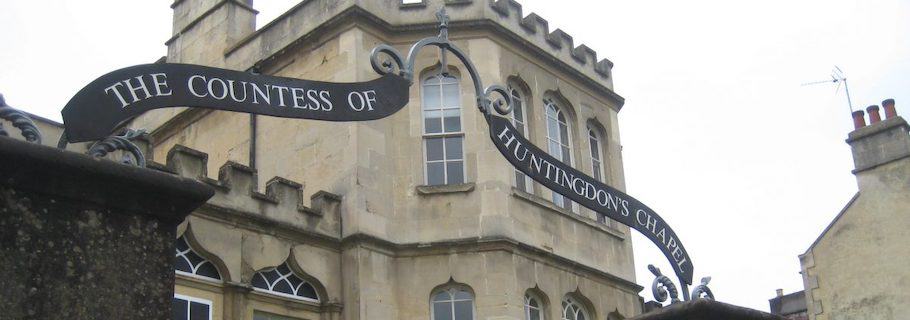As I’ve traveled the world over the past year, I’ve made many new friends. Some of these friends are living, but many more of them have long since gone to glory, and I’ve had to meet them through their biographies and through the objects they’ve left behind. One of my new friends is Selina Hastings, Countess of Huntingdon. In what follows, I want to briefly introduce you to her.
She was born into prominence. She was born on August 24, 1707 in the forty-room Astwell Manor House, a member of one of the oldest of England’s Aristocratic families, the Shirleys. Though the family was fantastically wealthy, it was also terribly unhappy, and Selina’s mother left her father when Selina was only six years old. She was left in the care of her father and soon showed herself a serious-minded child who often thought about the state of her soul.
She married into even greater prominence. Selina married Theophilus Hastings, the Ninth Earl of Huntingdon, on June 3, 1728, when she was 21 and he was 32. She was welcomed into the Hastings family by Theophilus’s sisters with whom she became close friends. Together they moved in the most elite circles and spent time with some of the most important figures of the time. Though her marriage to Theophilus was marked by great love and affection, it was also marked by illness and loss. Together they had seven children, only one of whom outlived her.
She got saved in 1739. Though Selina was always a moral and upright person, it was only in her early thirties that she began to realize that she was counting on her good deeds to earn merit with God. Under the preaching of the early Methodists, she came to faith in Jesus Christ sometime in mid-1739. Theophilus probably did as well, but the historical record is less certain for him. Though she remained in the Church of England, she was always associated with Methodists, something that damaged her reputation among her peers. She developed close friendships with John and Charles Wesley and with George Whitefield. She was especially close to Charles and his wife Sally, whom she loved almost as a daughter.
She reached out to her aristocratic peers. Soon after her conversion she became convinced that she should reach out to her peers with the gospel. Because of her association with Methodists, she did this at great cost to her reputation. One of them rebuked her, saying, “It is monstrous to be told that you have a heart as sinful as the common wretches that crawl on the earth. This is highly offensive and insulting; and I cannot but wonder that your Ladyship should relish any sentiments so much at variance with high rank and good breeding.” But she continued to share the gospel with nobility, monarchy, and commoners alike.
She took sides with George Whitefield. John Wesley eventually broke ranks with George Whitefield over issues related to Calvinism. Selina attempted to mediate this dispute, but was unsuccessful. Though she was initially persuaded by Wesley, through her own studies she came to prefer the Calvinistic interpretation of Scripture. She eventually hired Whitefield as her personal chaplain so he would preach on her estate. This allowed her to invite her aristocratic peers to hear the great gospel preacher of the age, and many came to saving faith.
She became one of the great philanthropists of her time. Blessed with great wealth, she determined to use what she had for God’s glory.
She was committed to training preachers. Having been saved by evangelical preaching, she was committed to training more preachers who would boldly proclaim the Word of God. For this reason she founded a seminary in Trevecca, Wales, under the leadership of Howell Harris. The initial students were men who had been expelled from Oxford for their Methodist leanings. The school opened in 1768 with Whitefield preaching to mark the occasion. (When she experienced trouble finding a Latin and Greek teacher, she soon hired a twelve-year-old prodigy to serve as a tutor!)
She was committed to biblical gender roles. Selina was committed to what today we might call “complementarian” principles related to gender roles, so she never preached or instructed preachers. Yet she certainly did encourage them, as proven by this letter from William Grimshaw: “What blessing did the Lord shower upon us the last time you were here! And how did our hearts burn within us to proclaim his love and grace to perishing sinners! Come and animate us afresh—aid us by your counsels and your prayers—communicate a spark of your glowing zeal, and stir us up to renewed activity in the cause of God.” Also, because she paid the salaries of a great number of preachers, she felt liberty to maintain an employer-employee relationship with many of them.
She was committed to financing local churches. Through her life she was involved in purchasing, renovating, and building local churches where evangelicals could preach. By the end of her life, she had 116 churches as part of her “Connexion” network, with more than 60 of them built or financed with her help. Though few of these survive today, a wonderful example is the chapel she built at Bath. Though it is now the Museum of Bath Architecture, much of the interior remains as it was, including the high pulpit where Whitefield preached the inaugural sermon. The museum has a small exhibit dedicated to her that includes a couple of items of particular interest.
She was a dedicated to praying and corresponding. Selina set aside significant time each day to read the Bible and pray for herself and others. She would also spend hours each day writing letters to her friends, family members, acquaintances, students, and preachers. These would often contain encouragements or theological teaching and reflection. Through her commitment to learning, she became a strong theologian.
She willingly deprived herself to support Christian ministry. All throughout her life, she gave with extreme generosity. She eventually went so far as to have her property plowed and planted with corn so she could earn an income from it. By the time she died, she had given away the vast majority of her wealth. A friend observed, “I believe she often possessed no more than the gown she wore.” She deprived herself of a lot of luxuries in order to carry out her work of philanthropy.
She died on June 17, 1791. She was 83 when she died and, according to her wishes, was buried with great simplicity. There was no great monument, no fancy coffin, and no crowd of mourners. Rather, she was buried in simplicity beside her husband with only three people in attendance.
Following her death, a friend remembered her in this way: “Thousands, I may say tens of thousands, in various parts of the kingdom heard the gospel through her instrumentality that in all probability would never have heard it at all; and I believe through eternity will have cause to bless God that she ever existed. She was truly and emphatically a Mother in Israel, and though she was far from a perfect character, yet I hesitate not to say that among the illustrious and noble of the country she has not left her equal.” But perhaps it was King George III who said it best: “I wish there was a Lady Huntingdon in every diocese in my kingdom.” May the Lord raise up many more like her!
There have been a number of biographies written about Selina Hastings. My top recommendation, and the only one still in print and widely available, is Selina Countess of Huntingdon by Faith Cook. It’s from her book that most of my information was drawn.










